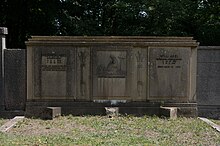Werner Abel
Werner Abel (born April 6, 1902 in Kiel ; † October 15, 1935 in Dachau concentration camp ) was a German journalist .
Live and act
Early life
Abel was a son of the merchant Wilhelm Abel. He went to school in Berlin.
After the First World War , in which he participated as a volunteer, Abel worked as a journalist and newsman.
On June 30, 1920, Abel was sentenced to six months 'imprisonment and two weeks' imprisonment by the appellate authority of the criminal chamber of the Tilsit regional court for fraud and a violation under Section 360 StGB, whereby the imprisonment and the prison sentence were considered to have been served.
After his release, Abel went to southern Germany, where he came into contact with circles on the extreme political right. According to his own statement, he belonged to the terrorist secret society Organization Consul in the early 1920s . Around 1922/1923 he was also temporarily active in the NSDAP . At that time he was known in Munich under the code name Prince Ysenburg. The pacifist publicist Kurt Hiller , who knew Abel personally, vigorously denied in a portrait of Abel in his 1950 book Heads and Trumps , citing Abel's mother, that "Prince Ysenburg" and Abel were identical.
Confrontation with National Socialism
In the later course of the 1920s Abel moved further and further politically to the left , so that he finally stood in the social democratic to communist camp. On May 20, 1928, on the occasion of the Reichstag elections of that year , he posted a poster in which he opposed South Tyrol policy and the NSDAP's financial sources. Among other things, Abel claimed that in autumn 1923 he acted as a liaison for the "East Prussian Patriotic Cartel" and the Munich legal circles between an Italian agent named Giuseppe Migliorati and Adolf Hitler . Like the leaders of other right-wing military organizations, Hitler received Italian money through Migliorati in order not to participate in the nationalists' propaganda in South Tyrol. After Abel repeated this accusation as a witness in a trial that Hitler led in February 1930 against Albrecht von Graefe , Ludwig Zerfass and a few others before the district court in Munich , Hitler filed a complaint against him for perjury.
The perjury proceedings against Abel, in which the Berlin psychiatrist Arthur Kronfeld had to testify as an expert witness, who got to know Hitler personally on this occasion, finally dragged itself through several instances until 1932. In June 1932 Abel was finally in the last instance by the District Court of Munich I found guilty and to three years' imprisonment convicted.
On the part of the National Socialists, Abel's accusations, which reached the climax of their publicity in the 1932 trial, were partly responsible for the fact that Hitler lost to Hindenburg in the 1932 presidential election. The strong impression that the Abel affair made on Hitler can be seen, among other things, in the fact that Hitler spoke about the Abel case in 1940 in a conversation with Joseph Goebbels , which the latter recorded in his diary.
death
After the National Socialists came to power, Abel was transferred to the Dachau concentration camp on September 4, 1935. He died there in 1935; officially by suicide. In the literature, however, it is often assumed that Abel was actually murdered and that his killing was officially declared a suicide. The Dachau prisoner Adolf Lemke claimed in a report prepared after the Second World War for the association of those persecuted by the Nazi regime that Abel had been murdered by the SS men Johann Kantschuster and Plank.
Archival tradition
A file from the former main archive of the NSDAP on the Werner Abel case has been preserved in the Federal Archives (Federal Archives Berlin: NS 26/1200). In addition, there is a file by the Reich Attorney at the Reichsgericht on the legal prosecution of Abel for an offense in the 1920s (R 3003/12, 12 J 928/24).
A post-war report by Adolf Lemke is in the holdings of the Association of Victims of the Nazi Regime , which is kept in the Federal Archives (DY 55 / V 278/6/1).
literature
- Günther Kimmel: The Dachau Concentration Camp. A study of Nazi violent crimes. In: Martin Broszat (Ed.): Rule and Society in Conflict (= Bavaria in the Nazi era. Volume II), Oldenbourg, Munich / Vienna 1979 p. 368.
- Othmar Plöckinger: History of a Book: Adolf Hitler's "Mein Kampf" 1922–1945. Oldenbourg, Munich 2006, p. 207.
Individual evidence
- ↑ Kurt Hiller: Heads and Trots. Profiles from a quarter of a century. Rowohlt, Hamburg - Stuttgart 1950, p. 376.
- ↑ Elke Fröhlich (ed.): The diaries of Joseph Goebbels. All fragments. Part I, Volume 4, Munich 1987, ISBN 3-598-21919-9 , p. 246 (entry from July 20, 1940).
- ^ Description of file DY 55 / V 278/6/1 on the website of the Federal Archives.
| personal data | |
|---|---|
| SURNAME | Abel, Werner |
| BRIEF DESCRIPTION | German journalist |
| DATE OF BIRTH | April 6, 1902 |
| PLACE OF BIRTH | Kiel |
| DATE OF DEATH | October 15, 1935 |
| Place of death | Dachau concentration camp |
